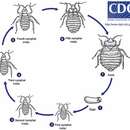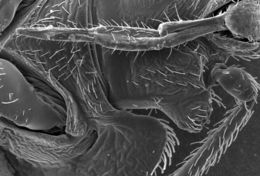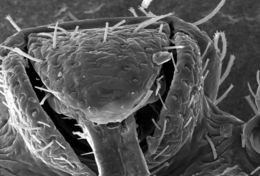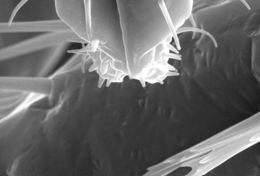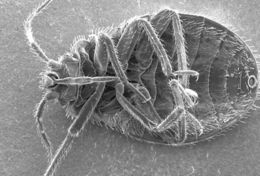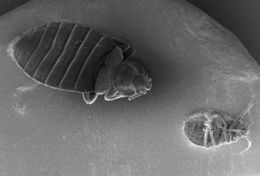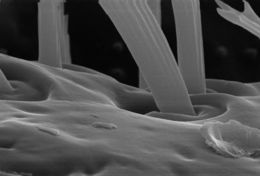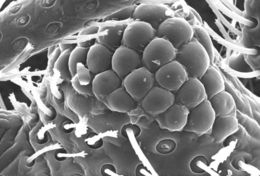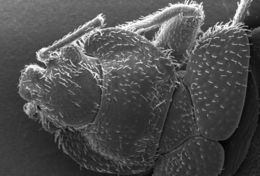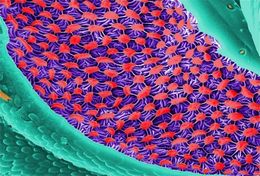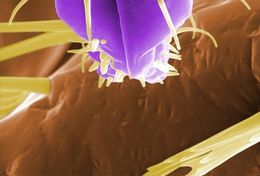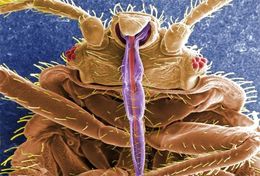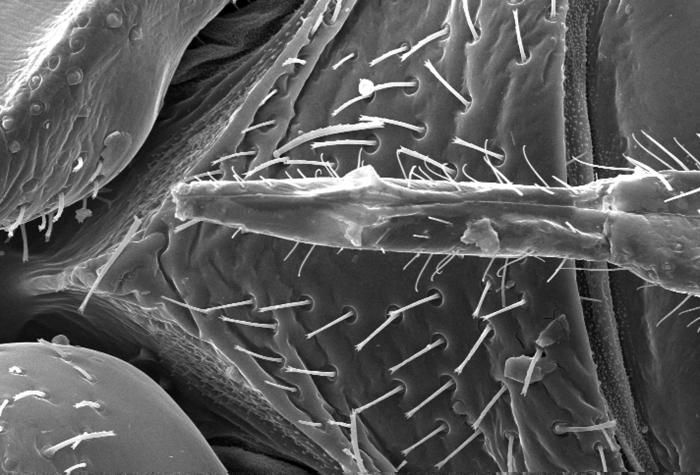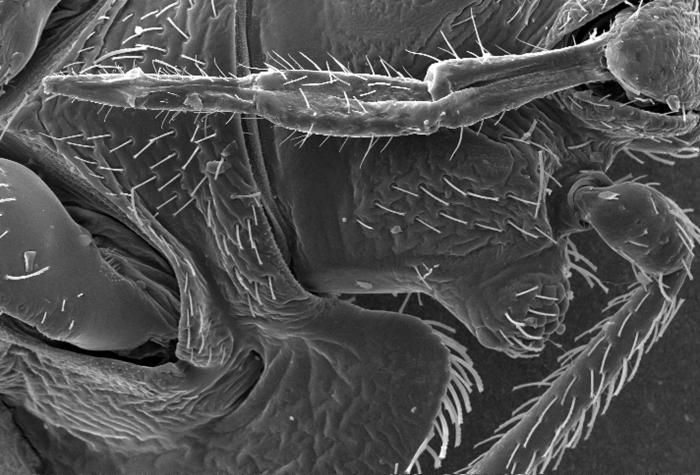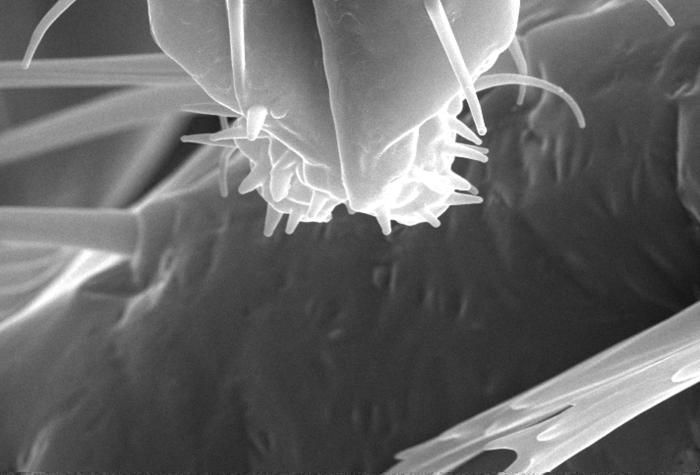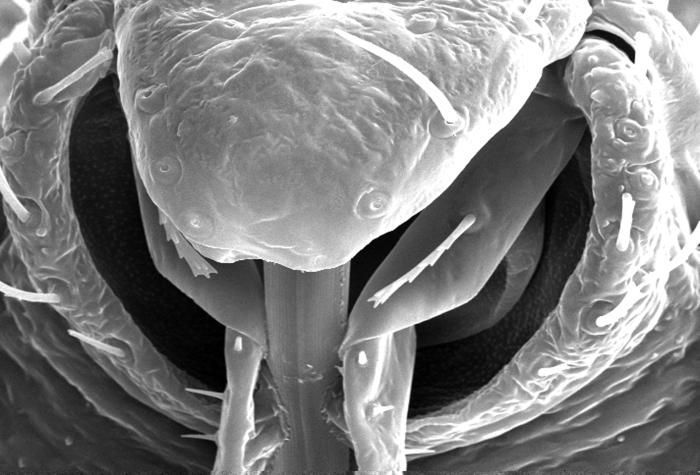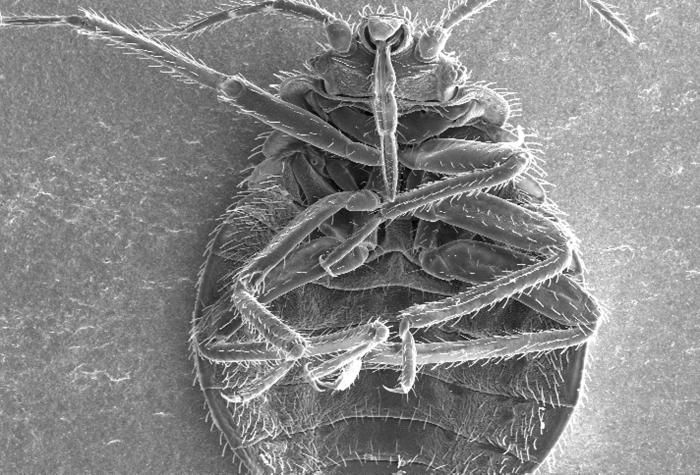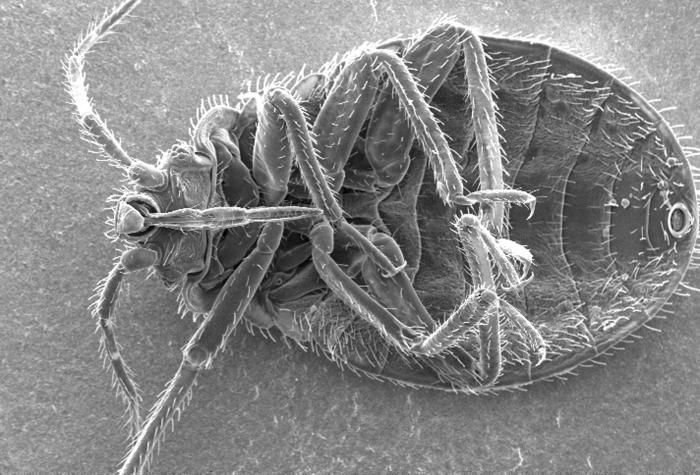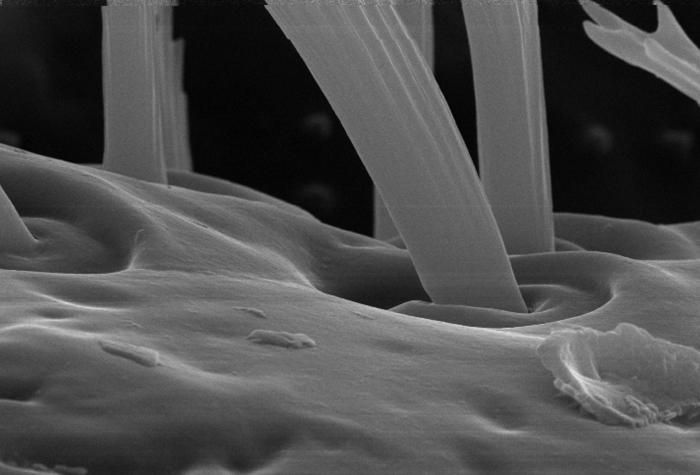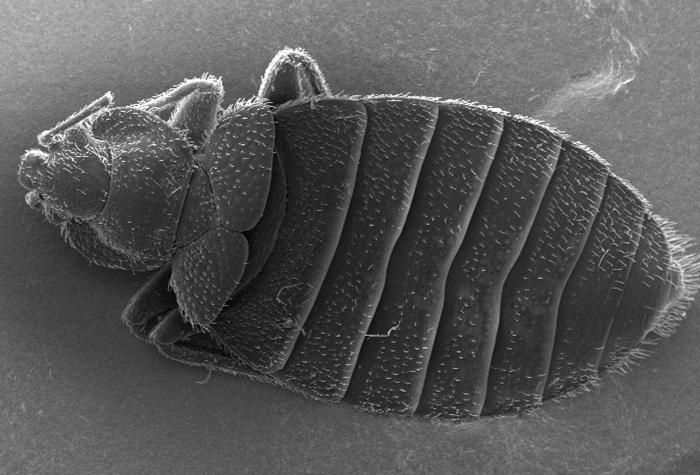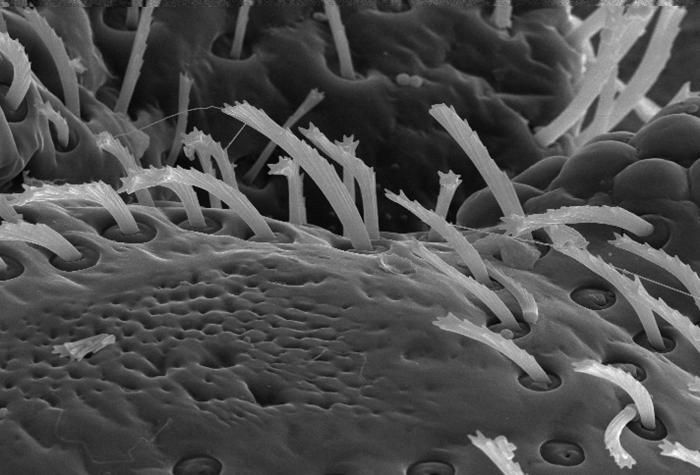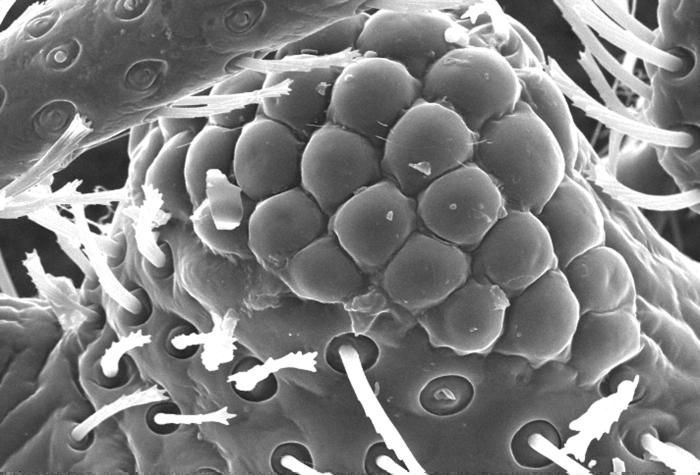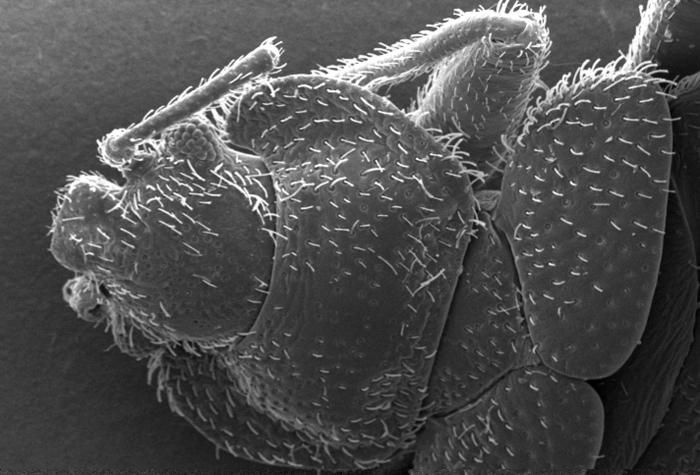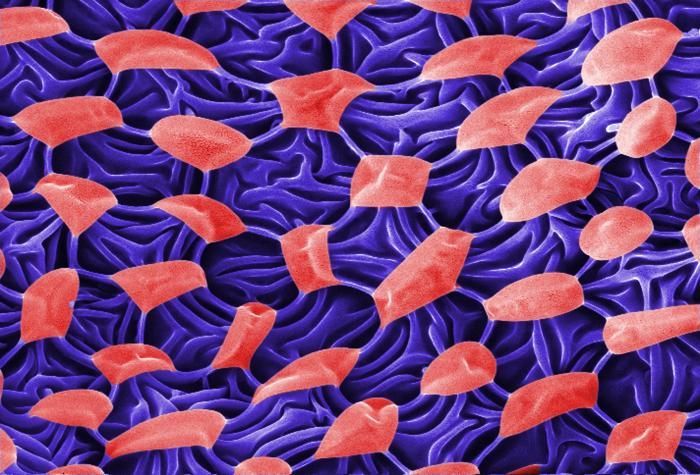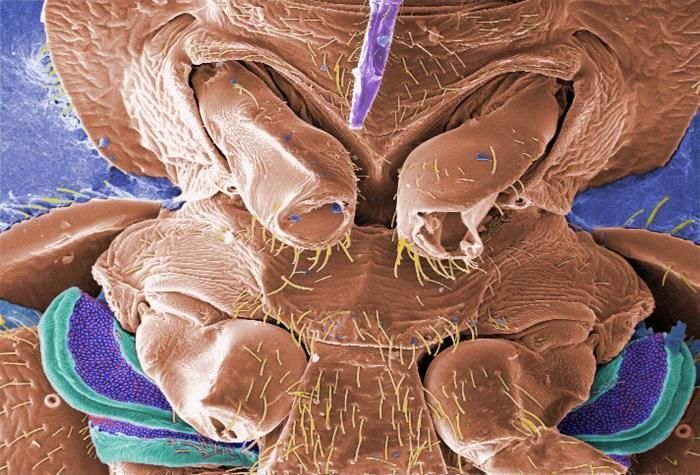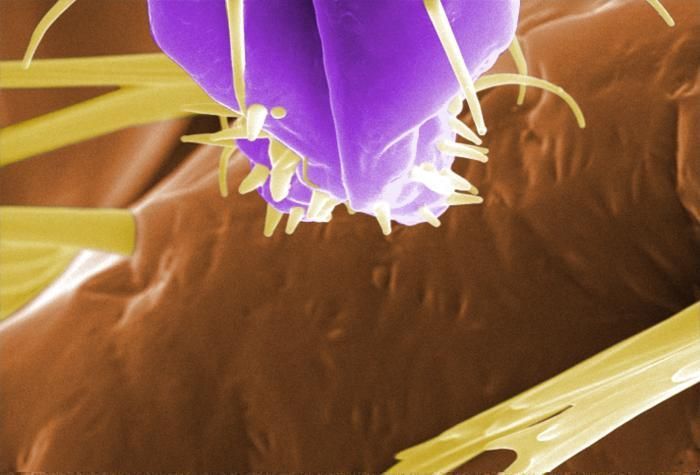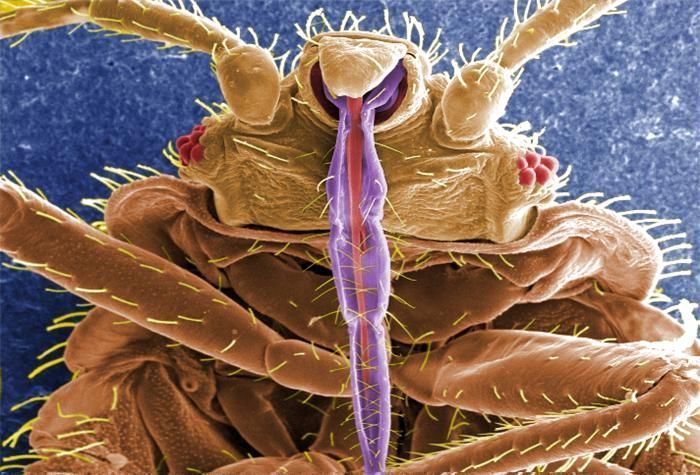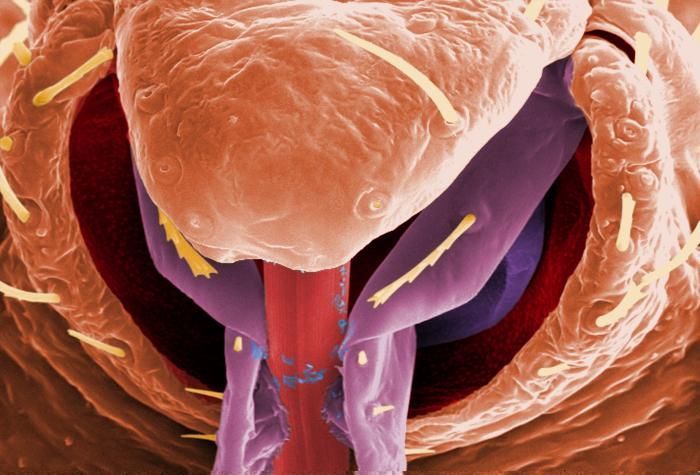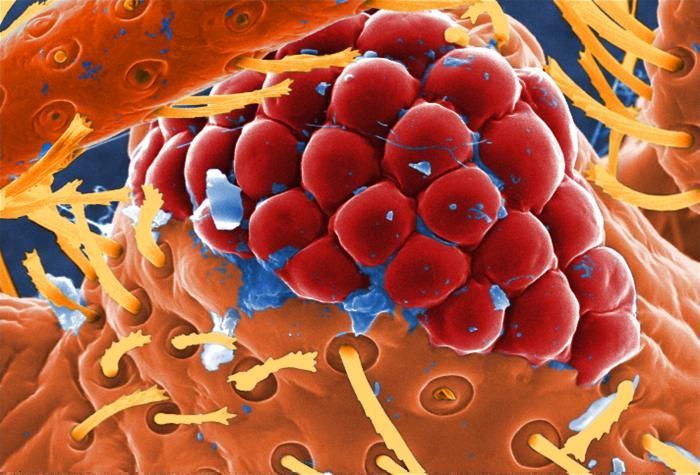-
This highly-magnified scanning electron micrograph (SEM) revealed some of the ultrastructural morphology displayed on the ventral surface of a bedbugs, Cimex lectularius, head and thorax. Note the distal anatomical relationships of the insects skin piercing mouthparts that it uses to obtain its blood meal.Clinical Features:Created: 2009
-
This scanning electron micrograph (SEM) revealed some of the ultrastructural morphology displayed on the ventral surface of a bedbugs, Cimex lectularius, head and thorax. Note the anatomical relationships of the insects skin piercing mouthparts that it uses to obtain its blood meal.Clinical Features:Created: 2009
-
This highly-magnified scanning electron micrograph (SEM) revealed some of the ultrastructural morphology displayed on the rostral head region of a bedbug, Cimex lectularius. Note the proximal anatomical relationships of the insects skin piercing mouthparts it uses to obtain its blood meal.Clinical Features:Created: 2009
-
This highly-magnified scanning electron micrograph (SEM) revealed some of the ultrastructural morphology displayed on the rostral head region of a bedbug, Cimex lectularius. Note the distal anatomical relationships of the insects skin piercing mouthparts used to obtain its blood meal. For a colorized version of this image see PHIL 11140.Clinical Features:Created: 2009
-
This highly-magnified, scanning electron micrograph (SEM) revealed some of the ultrastructural morphology displayed on the rostral head region of a bedbug, Cimex lectularius. Note the proximal anatomical relationships the insects skin piercing mouthparts it uses to obtain its blood meal, and how they join the head. For a colorized version of this image see PHIL 11738.Clinical Features:Although bedbugs have been found naturally-infected with blood-borne pathogens, they are not effective vectors of disease. The primary medical importance is inflammation associated with their bites (due to allergic reactions to components in their saliva).Created: 2009
-
This scanning electron micrograph (SEM) revealed some of the ultrastructural morphology displayed on the ventral surface of a bedbug, Cimex lectularius. From this view you can see the insects skin piercing mouthparts it uses to obtain its blood meal, as well as a number of its six jointed legs. For a colorized version of this image see PHIL 11739.Clinical Features:Created: 2009
-
This scanning electron micrograph (SEM) revealed some of the ultrastructural morphology displayed on the ventral surface of a bedbug, Cimex lectularius. From this view you can see the insects skin piercing mouthparts it uses to obtain its blood meal, as well as its six jointed legs.Clinical Features:Created: 2009
-
This scanning electron micrograph (SEM) revealed some of the ultrastructural morphology displayed on the ventral surface of a bedbug, Cimex lectularius. From this view you can see the insects skin piercing mouthparts it uses to obtain its blood meal.Clinical Features:Created: 2009
-
This scanning electron micrograph (SEM) revealed some of the ultrastructural morphology displayed on both the dorsal surface (LT), and ventral surface (RT) of two bedbugs, Cimex lectularius.Clinical Features:Created: 2009
-
This scanning electron micrograph (SEM) revealed some of the ultrastructural morphology displayed on the dorsal surface of a bedbug, Cimex lectularius. Note the numbers of what appear to be hairs, but are actually known as setae, which are sensorial in nature, and are composed of chitin, as is the entire exoskeleton.Clinical Features:Although bedbugs have been found naturally-infected with blood-borne pathogens, they are not effective vectors of disease. The primary medical importance is inflammation associated with their bites (due to allergic reactions to components in their saliva).Laboratory Diagnosis:The inflammatory reaction to the bites is not diagnostic, and confirmation of a bedbug bite is best achieved by identification of adults or nymphs collected in sheltered areas near where the patient was bitten. Bedbugs possess stink glands and emit a distinctive odor; homes or motel/hotel rooms with heavy infestations may have this odor.Created: 2009
-
This scanning electron micrograph (SEM) revealed some of the ultrastructural morphology displayed on the dorsal exoskeletal surface of a bedbug, Cimex lectularius. Note the numbers of what appear to be hairs, but are actually known as setae, which are sensorial in nature, and are composed of chitin, as is the entire exoskeleton.Chitin is a molecule made up of bound units of acetylglucosamine, joined in such a way as to allow for increased points at which hydrogen bonding can occur. In this way chitin provides increased strength, and durability as an exoskeletal foundation. A member of the phylum Arthropoda, this insect has three pairs of jointed legs, hence the name, Arthro = jointed, and poda = legs.Created: 2009
-
This scanning electron micrograph (SEM) revealed some of the ultrastructural morphology displayed on the exoskeletal surface of a bedbug, Cimex lectularius. In this particular view, numbers of what appear to be hairs, but are actually known as setae, which are sensorial in nature, and are composed of chitin, as is the entire exoskeleton.Chitin is a molecule made up of bound units of acetylglucosamine, joined in such a way as to allow for increased points at which hydrogen bonding can occur. In this way chitin provides increased strength, and durability as an exoskeletal foundation.Created: 2009
-
This highly magnified scanning electron micrograph (SEM) revealed some of the ultrastructural morphology displayed on the head region of a bedbug, Cimex lectularius. In this particular view, a single cavitation is featured, into which a single seta (pl. setae), would normally have been inserted. Though they appeare to be hairs, setae are not hairs at all, but sensory structures, which are composed of chitin, the same material as the rest of this organisms exoskeleton.Chitin is a molecule made up of bound units of acetylglucosamine, joined in such a way as to allow for increased points at which hydrogen bonding can occur. In this way chitin provides increased strength, and durability as an exoskeletal foundation.Bedbugs are not vectors in nature of any known human disease. Although some disease organisms have been recovered from bedbugs under laboratory conditions, none have been shown to be transmitted by bedbugs outside of the laboratory.Created: 2009
-
This scanning electron micrograph (SEM) revealed some of the ultrastructural morphology displayed on the head region of a bedbug, Cimex lectularius. In this particular view, what appeared to be hairs were not hairs at all, but sensory structures known as setae, which are composed of chitin, the same material as the rest of this organisms exoskeleton.Chitin is a molecule made up of bound units of acetylglucosamine, joined in such a way as to allow for increased points at which hydrogen bonding can occur. In this way chitin provides increased strength, and durability as an exoskeletal foundation.Bedbugs are not vectors in nature of any known human disease. Although some disease organisms have been recovered from bedbugs under laboratory conditions, none have been shown to be transmitted by bedbugs outside of the laboratory.Created: 2009
-
This scanning electron micrograph (SEM) revealed some of the ultrastructural morphology displayed on the head region of a bedbug, Cimex lectularius. Of interest is one of the insects compound eyes. For a colorized version of this image see PHIL 11736.The compound eye is given this name due to the fact that the single large eye is really made up of many repeating units known as "ommatidia. Each ommatidium is composed of separate units made up of a photoreceptor cell, support cell, and pigment cells. Though each of these visual mechanisms functions as a separate organ, together they provide the organism with a "compound picture of its environment. Due to what is referred to as the "flicker effect, the compound eye is made very sensitive to movement, with each ommatidium turning on and off, as objects pass across its field of view. The bilateral anatomical placement of the insect's eyes provides the organism with a very wide range of visual sensitivity.Created: 2009
-
This scanning electron micrograph (SEM) revealed some of the ultrastructural morphology displayed on the dorsal exoskeletal surface of a bedbug, Cimex lectularius. What appeared to be hair was not hair at all, but sensory structures known as setae, and are composed of chitin, the same material as the rest of this organisms exoskeleton. Chitin is a molecule made up of bound units of acetylglucosamine, joined in such a way as to allow for increased points at which hydrogen bonding can occur. In this way chitin provides increased strength, and durability as an exoskeletal foundation. For a colorized version of this image see PHIL 11735.Bedbugs are not vectors in nature of any known human disease. Although some disease organisms have been recovered from bedbugs under laboratory conditions, none have been shown to be transmitted by bedbugs outside of the laboratory.Created: 2009
-
This digitally-colorized scanning electron micrograph (SEM) revealed some of the ultrastructural morphology displayed on the ventral surface of a bedbug, Cimex lectularius. From this view, at the top, you can see the insects skin piercing mouthparts it uses to obtain its blood meal, as well as a number of its disarticulated six jointed legs. Youll also notice a beautiful diaphanous structure at the bottom of the image. It is speculated that this wondrous ultrastructural organ is most probably a scent gland, or related to the dissemination of scent, which may be pheromonal in nature. A further dissection of this, and the adjacent mesothoracic region, could possibly reveal an internalized aspect of this organ, which would be glandular in nature, and actually involved in the production of the aromatic chemical. Also, see PHIL 11741, 11742, and 11743 for successively greater magnifications of this marvelous structure.Created: 2009
-
This digitally-colorized scanning electron micrograph (SEM) revealed some of the ultrastructural morphology displayed on the ventral surface of a bedbug, Cimex lectularius. From this view, at the top, you can see the insects skin piercing mouthparts it uses to obtain its blood meal, as well as a number of its disarticulated six jointed legs. Youll also notice a beautiful diaphanous structure at the bottom of the image. It is speculated that this wondrous ultrastructural organ is most probably a scent gland, or related to the dissemination of scent, which may be pheromonal in nature. A further dissection of this, and the adjacent mesothoracic region, could possibly reveal an internalized aspect of this organ, which would be glandular in nature, and actually involved in the production of the aromatic chemical. Also, see PHIL 11741, 11742, and 11744 for successively greater magnifications of this marvelous structure.Created: 2009
-
This digitally-colorized scanning electron micrograph (SEM) revealed some of the ultrastructural morphology displayed on the ventral surface of a bedbug, Cimex lectularius. From this view, at the top, you can see the insects skin piercing mouthparts it uses to obtain its blood meal, as well as a number of its disarticulated six jointed legs. Youll also notice a beautiful diaphanous structure at the bottom of the image. It is speculated that this wondrous ultrastructural organ is most probably a scent gland, or related to the dissemination of scent, which may be pheromonal in nature. A further dissection of this, and the adjacent mesothoracic region, could possibly reveal an internalized aspect of this organ, which would be glandular in nature, and actually involved in the production of the aromatic chemical. Also, see PHIL 11741, 11743, and 11744 for successively greater magnifications of this marvelous structure.Created: 2009
-
This digitally-colorized scanning electron micrograph (SEM) revealed some of the ultrastructural morphology displayed on the ventral surface of a bedbug, Cimex lectularius. From this view, at the top, you can see the insects skin piercing mouthparts it uses to obtain its blood meal, as well as a number of its disarticulated six jointed legs. Youll also notice a beautiful diaphanous structure at the bottom of the image. It is speculated that this wondrous ultrastructural organ is most probably a scent gland, or related to the dissemination of scent, which may be pheromonal in nature. A further dissection of this, and the adjacent mesothoracic region, could possibly reveal an internalized aspect of this organ, which would be glandular in nature, and actually involved in the production of the aromatic chemical. See PHIL 11742, 11743, and 11744 for successively greater magnifications of this marvelous structure.Created: 2009
-
This highly-magnified digitally-colorized scanning electron micrograph (SEM) revealed some of the ultrastructural morphology displayed on the rostral head region of a bedbug, Cimex lectularius. Note the distal anatomical relationships the insects skin piercing mouthparts it uses to obtain its blood meal.Clinical Features:Created: 2009
-
This digially-colorized scanning electron micrograph (SEM) revealed some of the ultrastructural morphology displayed on the ventral surface of a bedbug, Cimex lectularius. From this view you can see the insects skin piercing mouthparts it uses to obtain its blood meal, as well as a number of its six jointed legs.Clinical Features:Created: 2009
-
This highly-magnified, digitally-colorized scanning electron micrograph (SEM) revealed some of the ultrastructural morphology displayed on the rostral head region of a bedbug, Cimex lectularius. Note the proximal anatomical relationships the insects skin piercing mouthparts it uses to obtain its blood meal, and how they join the head.Clinical Features:Created: 2009
-
This digitally-colorized scanning electron micrograph (SEM) revealed some of the ultrastructural morphology displayed on the head region of a bedbug, Cimex lectularius. Of interest is one of the insects compound eyes.The compound eye is given this name due to the fact that the single large eye is really made up of many repeating units known as "ommatidia. Each ommatidium is composed of separate units made up of a photoreceptor cell, support cell, and pigment cells. Though each of these visual mechanisms functions as a separate organ, together they provide the organism with a "compound picture of its environment. Due to what is referred to as the "flicker effect, the compound eye is made very sensitive to movement, with each ommatidium turning on and off, as objects pass across its field of view. The bilateral anatomical placement of the insect's eyes provides the organism with a very wide range of visual sensitivity.Created: 2009

